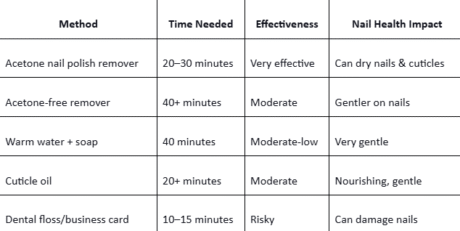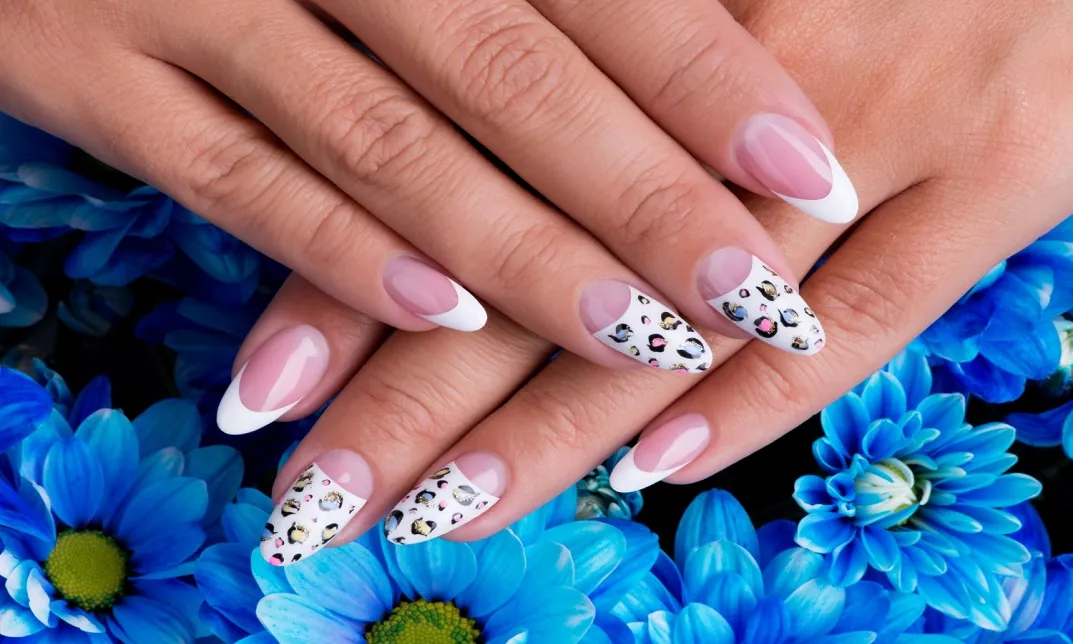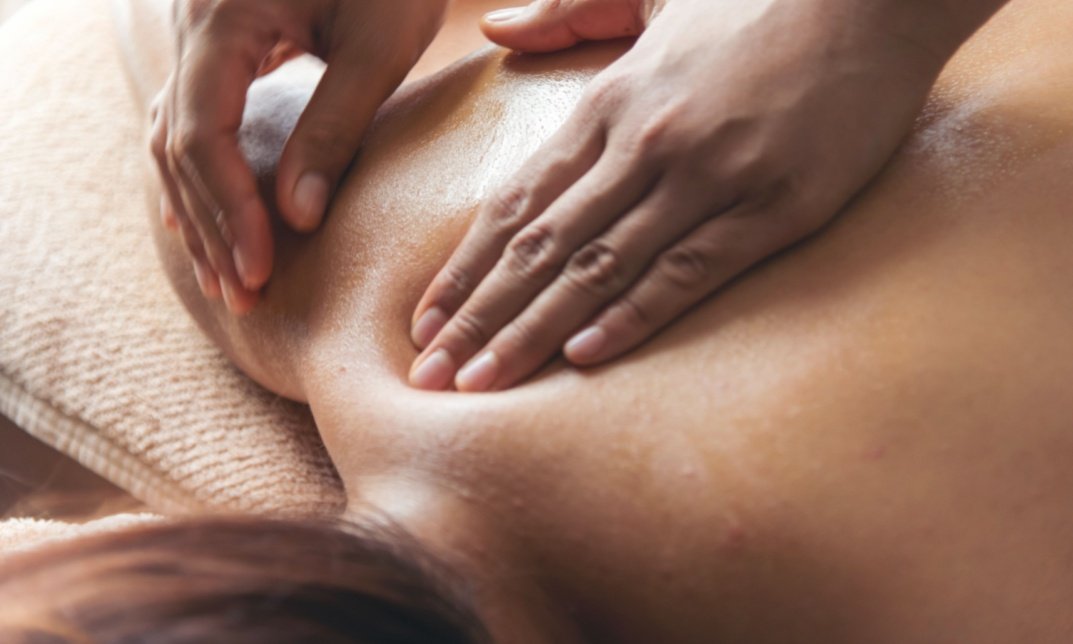No products in the cart.
Acrylic nails are bold, glamorous, and long-lasting — but removing them can be tricky. Many people wonder: can I take acrylic nails off with nail polish remover?
The short answer is yes — but it depends on the type of nail polish remover. Standard nail polish removers that contain acetone are effective at breaking down acrylics, while non-acetone removers may not work as well and usually require more time and effort. If you only have acetone-free remover, the process is slower, but with the right technique, you can still take your acrylic nails off at home.
This guide explains every safe method for removing acrylic nails — with and without acetone — plus tips to protect your natural nails and keep them healthy afterward.
Why People Want to Remove Acrylic Nails at Home
Acrylic nails look beautiful, but they don’t last forever. After 2–3 weeks, they can grow out, lift, or chip, making removal necessary. Many people return to salons for professional removal, but there are plenty of reasons to try taking them off at home:
- Save money: Salons charge extra for acrylic removal.
- Convenience: You can do it on your own schedule without booking an appointment.
- Safety concerns: Frequent acetone exposure can leave nails dry and brittle.
- Curiosity and DIY skills: Many want to learn how to handle nail care themselves.
Before you start, it’s important to understand how nail polish remover works on acrylics and which options are safest.
Can I Take Acrylic Nails Off With Nail Polish Remover?
Yes — if the remover contains acetone. Acetone is a strong solvent that breaks down the acrylic material, making it easier to remove. However, acetone can also dry out your nails and cuticles. That’s why many people look for gentler alternatives.
If you’re using acetone-free nail polish remover, the process is possible but more time-consuming. It may take 40 minutes or longer, and you’ll usually need to combine it with soaking, filing, or prying methods.
Pros and Cons of Nail Polish Remover for Acrylic Nails
Benefits
- Easy to find in any drugstore.
- Effective if it contains acetone.
- Faster than non-chemical methods.
- Allows you to remove acrylics at home without professional help.
Downsides
- Acetone is harsh: Can cause dryness, brittleness, and irritation.
- Time-consuming without acetone: Requires long soaks and patience.
- Risk of nail damage: If you pry too hard, you can peel layers of your natural nail.
Tools You’ll Need for At-Home Removal

Before starting, gather these supplies:
- Nail polish remover (acetone or non-acetone)
- Cotton balls or pads
- Aluminum foil (if using acetone-soak method)
- Nail clippers
- Nail file and buffer
- Orangewood stick or cuticle pusher
- Bowl (for soaking)
- Cuticle oil
- Hand cream or moisturizer
Having everything ready makes sure the process goes smoothly without interruptions.
How to Remove Acrylic Nails With Acetone Nail Polish Remover
The most effective method uses acetone-based nail polish remover. Here’s a safe, step-by-step process:
Step 1: Trim the Acrylics
Clip your acrylic nails down to a shorter, manageable length. Avoid cutting too close to your natural nail.
Step 2: File the Top Layer
Using a nail file, buff the acrylic’s lustrous finish. This step helps acetone penetrate more effectively.
Step 3: Soak Cotton Balls in Acetone
Fully saturate cotton balls with acetone-based remover.
Step 4: Apply and Wrap
Apply the moistened cotton balls to your nails and wrap each fingertip in aluminium foil. This traps heat and speeds up the breakdown process.
Step 5: Wait 20–30 Minutes
Allow the acetone to soften the acrylic. Avoid rushing; patience ensures less damage.
Step 6: Gently Remove Acrylic
Unwrap one nail at a time. Use an orangewood stick to push off the softened acrylic. If it doesn’t come off easily, rewrap and soak longer.
Step 7: Buff and Moisturize
After removal, buff away residue and apply cuticle oil plus moisturizer to restore hydration.
How to Remove Acrylic Nails Without Acetone
If you prefer to avoid acetone, you can still remove acrylics using gentler methods. These require more time and patience but are less drying.
1. Acetone-Free Nail Polish Remover
- Clip and file nails short.
- Soak nails in a bowl of acetone-free remover for 40+ minutes.
- Gently pry off the loosened acrylic with tweezers or a cuticle stick.
2. Warm Water and Soap
- Fill a bowl with warm, soapy water.
- Soak nails for 30–40 minutes.
- Wiggle and gently lift nails once softened.
3. Cuticle Oil
- Apply oil under lifting acrylics with a cotton ball.
- Let it seep underneath for 5–10 minutes.
- Use a cuticle stick to nudge acrylics off.
4. Dental Floss Method
- Requires an assistant or floss pick.
- Slide floss under the acrylic nail and gently work it forward.
- Riskier, but can be effective on already-loosened nails.
5. Business Card Technique
- Use a cuticle stick to lift the edge.
- Slide a business card between acrylic and natural nail.
- Gently push until the acrylic pops off.
Comparing Acetone vs. Non-Acetone Methods

How to Care for Your Natural Nails After Removal
Even with careful removal, your nails may feel weak or dry. Post-removal care is essential.
- Moisturize daily: Put on cuticle oil and hand cream.
- Keep nails trimmed: Prevents breakage while they recover.
- Buff gently: Smooth ridges but avoid aggressive filing.
- Avoid immediate reapplication: Let natural nails breathe before applying new acrylics or gel polish.
- Strengthening treatments: Use keratin-based nail strengtheners.
- Diet support: Biotin-rich foods (eggs, nuts, salmon) can promote healthier growth.
Extra Tips for Safe At-Home Acrylic Removal
- Always work in a well-ventilated space when using acetone.
- Never force acrylics off — if they resist, soak longer.
- Use lukewarm, not hot, water to avoid skin irritation.
- Wear gloves when washing dishes or cleaning up after removal.
Mistakes to Avoid When Removing Acrylic Nails
- Pulling or prying too hard: Leads to peeling layers of your natural nail.
- Skipping moisturizer: Causes brittle, weak nails.
- Using metal tools aggressively: Can scratch nail beds.
- Not giving nails a break: Constant acrylic use prevents natural healing.
When to See a Professional
DIY removal is possible, but certain situations call for professional help:
- If your nails are infected or painful.
- If acrylics were applied too thick or bonded strongly.
- If you’re unsure or nervous about damaging your nails.
A nail technician can remove acrylics safely and suggest treatments if your natural nails are compromised.
Frequently Asked Questions (FAQs)
- Can I take acrylic nails off with regular nail polish remover?
-
- If it contains acetone, yes. If not, the process is possible but slower and less effective.
- How long does it take to remove acrylic nails at home?
-
- With acetone: 20–30 minutes. Without acetone: 40–60 minutes.
- Is acetone harmful to natural nails?
-
- Not permanently, but it can dry and weaken nails temporarily. Always follow with moisturizer and cuticle oil.
- Can I reuse my acrylic nails after removal?
-
- No. Once removed, acrylics are damaged and unsanitary to reapply.
- What’s the safest method for sensitive nails?
-
- Warm water with soap or cuticle oil, though they require more patience.
- Can I combine methods?
-
- Yes — for example, soaking in warm water first, then using acetone-free remover, may speed up the process.
Conclusion
So, can you take acrylic nails off with nail polish remover? Absolutely — but acetone-based removers work best. They break down acrylic quickly and safely if used with patience. Acetone-free removers and gentler methods like cuticle oil or warm water also work but require more time.
No matter which method you choose, the most important step is aftercare. Moisturizing, trimming, and letting your natural nails recover will keep them healthy and strong.
If in doubt, visit a professional nail technician for safe removal. But with the right tools and knowledge, you can confidently remove acrylic nails at home — saving money, avoiding salon trips, and protecting your natural nails.







